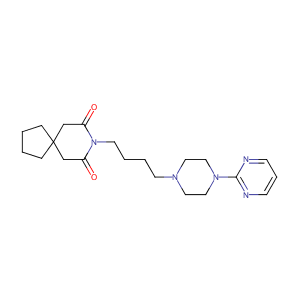| 1 |
ClinicalTrials.gov (NCT02273154) RandomizedControlled and Open-label Study of Buspirone add-on Treatment in Patients With Major Depression Disorder
|
| 2 |
Paroxetine FDA Label
|
| 3 |
URL: http://www.guidetopharmacology.org Nucleic Acids Res. 2015 Oct 12. pii: gkv1037. The IUPHAR/BPS Guide to PHARMACOLOGY in 2016: towards curated quantitative interactions between 1300 protein targets and 6000 ligands. (Ligand id: 4790).
|
| 4 |
URL: http://www.guidetopharmacology.org Nucleic Acids Res. 2015 Oct 12. pii: gkv1037. The IUPHAR/BPS Guide to PHARMACOLOGY in 2016: towards curated quantitative interactions between 1300 protein targets and 6000 ligands. (Ligand id: 36).
|
| 5 |
Drugs@FDA. U.S. Food and Drug Administration. U.S. Department of Health & Human Services.
|
| 6 |
Improving the prediction of the brain disposition for orally administered drugs using BDDCS. Adv Drug Deliv Rev. 2012 Jan;64(1):95-109.
|
| 7 |
New orally active anticoagulant agents for the prevention and treatment of venous thromboembolism in cancer patients. Ther Clin Risk Manag. 2014 Jun 13;10:423-36.
|
| 8 |
CYP1A2 genetic polymorphisms are associated with treatment response to the antidepressant paroxetine. Pharmacogenomics. 2010 Nov;11(11):1535-43.
|
| 9 |
Clinical pharmacogenetics implementation consortium (CPIC) guideline for CYP2D6 and CYP2C19 genotypes and dosing of selective serotonin reuptake inhibitors. Clin Pharmacol Ther. 2015 Aug;98(2):127-34.
|
| 10 |
Identification of cytochrome P450 isoforms involved in the metabolism of paroxetine and estimation of their importance for human paroxetine metabolism using a population-based simulator. Drug Metab Dispos. 2010 Mar;38(3):376-85.
|
| 11 |
ABCB1 (MDR1) gene polymorphisms are associated with the clinical response to paroxetine in patients with major depressive disorder. Prog Neuropsychopharmacol Biol Psychiatry. 2008 Feb 15;32(2):398-404. doi: 10.1016/j.pnpbp.2007.09.003. Epub 2007 Sep 15.
|
| 12 |
Serotonin transporter mRNA expression in peripheral leukocytes of patients with major depression before and after treatment with paroxetine. Neurosci Lett. 2005 Nov 25;389(1):12-6. doi: 10.1016/j.neulet.2005.06.048.
|
| 13 |
Immunomodulatory effect of selective serotonin reuptake inhibitors (SSRIs) on human T lymphocyte function and gene expression. Eur Neuropsychopharmacol. 2007 Dec;17(12):774-80.
|
| 14 |
Direct and metabolism-dependent cytochrome P450 inhibition assays for evaluating drug-drug interactions. J Appl Toxicol. 2013 Feb;33(2):100-8.
|
| 15 |
Effects of selective serotonin reuptake inhibitors on three sex steroids in two versions of the aromatase enzyme inhibition assay and in the H295R cell assay. Toxicol In Vitro. 2015 Oct;29(7):1729-35.
|
| 16 |
Paroxetine modulates immune responses by activating a JAK2/STAT3 signaling pathway. J Biochem Mol Toxicol. 2020 May;34(5):e22464. doi: 10.1002/jbt.22464. Epub 2020 Feb 5.
|
| 17 |
Evaluation of platelet activation in depressed patients with ischemic heart disease after paroxetine or nortriptyline treatment. J Clin Psychopharmacol. 2000 Apr;20(2):137-40. doi: 10.1097/00004714-200004000-00004.
|
| 18 |
Impact of selective serotonin reuptake inhibitors on neural crest stem cell formation. Toxicol Lett. 2017 Nov 5;281:20-25. doi: 10.1016/j.toxlet.2017.08.012. Epub 2017 Aug 24.
|
| 19 |
Antidepressant induced cholestasis: hepatocellular redistribution of multidrug resistant protein (MRP2). Gut. 2003 Feb;52(2):300-3. doi: 10.1136/gut.52.2.300.
|
| 20 |
Genome-wide expression profiling of human lymphoblastoid cell lines identifies CHL1 as a putative SSRI antidepressant response biomarker. Pharmacogenomics. 2011 Feb;12(2):171-84. doi: 10.2217/pgs.10.185.
|
| 21 |
Prediction of response to paroxetine and venlafaxine by serotonin-related genes in obsessive-compulsive disorder in a randomized, double-blind trial. J Clin Psychiatry. 2007 May;68(5):747-53. doi: 10.4088/jcp.v68n0512.
|
| 22 |
Interactions between corticotropin-releasing hormone and serotonin: implications for the aetiology and treatment of anxiety disorders. Handb Exp Pharmacol. 2005;(169):181-204.
|
| 23 |
Effects of cytochrome P450 (CYP) 3A4 inhibitors on the anxiolytic action of tandospirone in rat contextual conditioned fear. Prog Neuropsychopharmacol Biol Psychiatry. 2007 May 9;31(4):926-31.
|
| 24 |
Cytochrome P450 3A-mediated metabolism of buspirone in human liver microsomes. Drug Metab Dispos. 2005 Apr;33(4):500-7.
|
| 25 |
Drug Interactions Flockhart Table
|
| 26 |
The bacterial P450 BM3: a prototype for a biocatalyst with human P450 activities. Trends Biotechnol. 2007 Jul;25(7):289-98.
|
| 27 |
Effect of common medications on the expression of SARS-CoV-2 entry receptors in liver tissue. Arch Toxicol. 2020 Dec;94(12):4037-4041. doi: 10.1007/s00204-020-02869-1. Epub 2020 Aug 17.
|
| 28 |
Hormonal responses to the 5-HT1A agonist buspirone in remitted endogenous depressive patients after long-term imipramine treatment. Psychoneuroendocrinology. 2010 May;35(4):481-9. doi: 10.1016/j.psyneuen.2009.08.012. Epub 2009 Sep 16.
|
|
|
|
|
|
|


